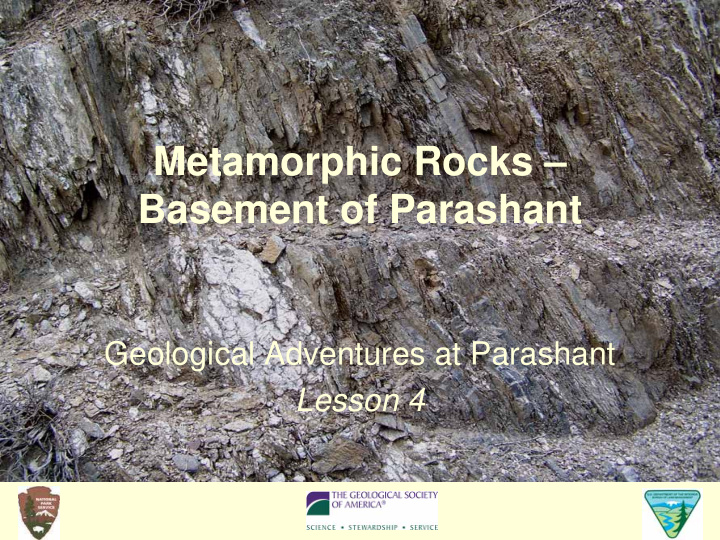



Metamorphic Rocks – Basement of Parashant Geological Adventures at Parashant Lesson 4
Objectives • Metamorphism changes one kind of rock into another kind of rock. • Several ways that heat and pressure change rocks. • Metamorphic rocks are derived from and related to other rocks. • Why metamorphic rocks form the basement rocks of Parashant.
Materials and Set Up Figure 1 . Materials Figure 2 Slicing the end of the needed for the activity. model to make a clean face. Save scraps for later lessons.
Figure 3 Side view (length), end view (width), and height of clay model prior to it being compressed.
Figure 4 Model after being compressed by a book.
Figure 5 Clay model after being compressed, showing length, width, and height.
Figure 7 Side view of Figure 6 Side view of sliced model after model after folding. folding.
Table 1. Changing Dimensions of a Clay Model of Metamorphic Rock Time Length (cm) Width (cm) Height (cm) Before Pressure is Applied After Pressure is Applied Change (+ or -)
Table 2. Metamorphic Rock Identification Chart Texture Composition; Color, and Features Parent Rock Rock Name Foliated - very Dull; Rings when struck on desk. Shale or Slate fine grained- mudstone no visible Shiny due to increased size of mica minerals Shale or Phyllite minerals (almost see them) mudstone Foliated - Individual mineral grains visible Slate Schist medium to coarse grain Color banded Alternating layers of light (felsic) and dark (mafic) Schist Gneiss minerals Non-foliated with Calcite; Light; Softer than glass; Reacts with Limestone or Marble non-oriented hydrochloric acid Dolomite grains Carbon; Dark; Shiny; Breaks with a conchoidal Bituminous Anthracite fracture coal coal Quartz; Light to dark; Harder than glass Sandstone Quartzite
FIGURE 4.1 Metamorphic rocks form the core of the Virgin Mountains at Parashant.
FIGURE 4.2 Heat and pressure cause minerals to become foliated or banded during metamorphism.
FIGURE 4.3 How do the folds in this gneiss compare with the folds in your clay model?
FIGURE 4.4 The change in color at the top of the red sandstone caused when hot molten lava (now a layer of black basalt) flowed over it is due to contact metamorphism.
FIGURE 4.5 Metamorphic rocks in the Virgin Mountains were exposed by uplift and erosion. Note how the rocks are turned on end.
FIGURE 4.6 Schist at FIGURE 4.7 Gneiss at Parashant. Penny for scale. Parashant. Penny for scale.
FIGURE 4.8 Metamorphic rock from the Virgin Mountains at Parashant (penny for scale).
Recommend
More recommend